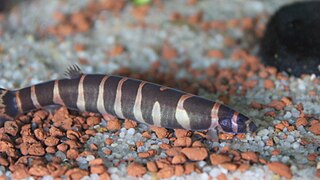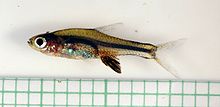
Pangio is a genus of small Asian freshwater fish in the true loach family Cobitidae. In earlier taxonomic schemes it was known as Acanthophthalmus. The "kuhli loach" is well-known in the aquarium trade and commonly identified as P. kuhlii, but most individuals actually appear to be P. semicincta.

Sundadanio axelrodi is a species of freshwater ray-finned fish belonging to the family Sundadanionidae, the tiny danios. This fish is known only from Bintan Island in the Riau Islands east of Sumatra. Originally described as a rasbora, Rasbora axelrodi, this tiny species was later deemed to be more closely related to the danios but not enough to be moved into the genus Danio. Sundadanio axelrodi reaches a maximum size of 1.7 cm. Sundadanio was considered monotypic until the genus was reassessed by Conway, Kottelat and Tan in 2011.

Psilorhynchus is a genus of ray-finned fish in the family Psilorhynchidae native to South Asia. This genus is the only member of its family. The members of Psilorhynchus are small benthic fishes which occur in rivers and streams with fast to swift currents, hence they are often referred to as torrent minnows. They are distributed in southern Asia, in the Indo-Burma region and the Western Ghats.

Cyclocheilichthys is a genus of ray-finned fish in the family Cyprinidae containing approximately nine valid species. They are native to freshwater habitats in Southeast Asia and China.
Physoschistura is a genus of fish in the family Nemacheilidae found mostly in Southeast Asia.
Longiculter is a monospecific genus of freshwater ray-finned fish belonging to the family Xenocyprididae, the East Asian minnows or sharpbellies. The only species in the genus is Longiculter siahi. This fish is found in Southeast Asia where it is found in Cambodia, Laos and Thailand. It is the only member of its genus. It was described by the American ichthyologist Henry Weed Fowler from two specimens collected from central Thailand in 1937. There have been no further records of this species from Thailand and there is some doubt as to the validity of this species. There have been reports of this species from Cambodia in 1985 and from southern Lao PDR but the identification has yet to be confirmed. The IUCN therefore classify this species as Data Deficient.

Mystacoleucus is a genus of freshwater ray-finned fish belonging to the family Cyprinidae, the family which includes the carps, barbs, minnows and related fishes. The fishes in this genus are found in Southeast Asia.

Osteochilus is a genus of freshwater ray-finned fish belonging to the family Cyprinidae, the family which includes the carps, barbs, minnows and related fishes. The fishes in this genus are mainly found in Southeast Asia with a few extending into adjacent parts of China.

Oxygaster is a genus of freshwater ray-finned fish belonging to the family Xenocyprididae, the East Asian minnows or sharpbellies. The species in this genus are found in Southeast Asia.
Rasborichthys is a monospecific genus of freshwater ray-finned fish belonging to the family Xenocyprididae, the East Asian minnows or sharpbellies. The only species in the genus is Rasborichthys helfrichii a fish found on the islands of Sumatra and Borneo in Southeast Asia.
Fangfangia is a monospecific genus of freshwater ray-finned fish belonging to the family Sundadanionidae, the tiny danios. The only species in the genus is Fangfangia spinicleithralis a species endemic to Indonesia where it is found in the peat swamp forests of Kalimantan Tengah, Borneo. The genus name Fangfangia honors the Chinese-Swedish ichthyologist Fang Fang Kullander, who specialized in the study of cyprinid fishes.

Pseudohomaloptera is a genus of freshwater ray-finned fish belonging to the family Balitoridae, the river or hillstream loaches. The species in this genus are found in eastern Asia.
Sundadanio atomus is a species of freshwater ray-finned fish belonging to the family Sundadanionidae, the tiny danios. It is endemic to Singkep, off Sumatra (Indonesia). It lives in peat swamp forests.
Sundadanio echinus is a species of freshwater ray-finned fish belonging to the family Sundadanionidae, the tiny danios. It is endemic to Borneo and found in West Kalimantan (Indonesia) and western Sarawak (Malaysia). It lives in peat swamps and blackwater streams.
Sundadanio gargula is a species of freshwater ray-finned fish belonging to the family Sundadanionidae, the tiny danios. It is endemic to Bangka Island, off Sumatra (Indonesia). It lives in coastal peat swamp forests.
Sundadanio goblinus is a species of freshwater ray-finned fish belonging to the family Sundadanionidae, the tiny danios. It is endemic to Sumatra (Indonesia). It lives in coastal peat swamp forests.
Sundadanio margarition is a species of freshwater ray-finned fish belonging to the family Sundadanionidae, the tiny danios. It is endemic to Sarawak, Malaysian Borneo, and known from the Rajang and Sarawak River drainages. It lives in coastal peat swamp forests.
Sundadanio retiarius is a species of freshwater ray-finned fish belonging to the family Sundadanionidae, the tiny danios. It is endemic to Kalimantan, Indonesian Borneo, and known from the Kotawaringin and Kahayan River drainages. It lives in peat swamps and blackwater streams.
Sundadanio rubellus is a species of freshwater ray-finned fish belonging to the family Sundadanionidae, the tiny danios. It is endemic to Kalimantan, Indonesian Borneo, and known from the southern Kapuas River delta. It lives in peat swamp forests.

Sundadanionidae, the tiny danios, is a family of freshwater ray-finned fishes belongong to the suborder Cyprinoidei of the order Cypriniformes. The fishes in this family are endemic to Indonesia.








